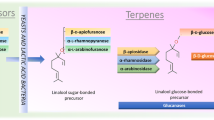Abstract
Eight wines were made from two Canadian hybrid grape varieties (Maréchal Foch, Baco Noir) and two Hungarian Vitis vinifera varieties (Kadarka, Lemberger). One half was kept untreated and the other half received a commercial yeast preparation (OptiRed®) before fermentation. The wines were subjected to descriptive analysis of the oral sensations elicited by a trained sensory panel. Analysis of variance showed that the varieties differed for 12 of the 13 attributes examined. Principal components analysis (PCA) assisted in characterising the sensory profile of each wine. Maréchal Foch produced wines with the highest viscosity, while Baco Noir wines were characterised by high-intensity scores for heat and irritation. Kadarka was differentiated from other wines by the low intensity of the astringency sub-qualities, and Lemberger wines were characterised by their higher perceived acidity and particulate in-mouth scores. The addition of OptiRed® had no impact on any of the oral sensations assessed. PCA on the combined sensory and analytical data sets showed that both sensory and physico-chemical parameters were important in defining the factors and in separating individual wines, which were grouped closely in the PCA space by variety. While many significant associations were found between the sensory and analytical attributes, we conclude that pH and ethanol are responsible for many of the observed sensory differences.


Similar content being viewed by others
References
Gawel R, Oberholster R, Francis IL (2000) Aust J Grape Wine Res 6:203–207
Geddes DJ, Bell SJ, Holzapfel BP, Rogiers SY, Pickering GJ (2001) Astringency sub-qualities elicited by red wine––the effects of viticultural practises. In: Proceedings of the 4th Pangborn sensory science symposium, Dijon, France, 22–26 July, 2001. INRA-UMRA, 86
Gawel R, Iland PG, Francis IL (2001) Food Qual Prefer 12:83–94 doi:10.1016/S0950–3293(00)00033–1
DeMiglio P, Pickering GJ, Reynolds AG (2002) Astringent sub-qualities elicited by red wine: the role of ethanol and pH. In: Cullen CW, Pickering GJ, Phillips R (eds) Proceedings of the international Bacchus to the future conference, St Catharines, Ontario, 23–25, 2002, pp 31–52
Francis IL, Gawel R, Iland PG, Vidal S, Cheynier V, Guyot S, Kwiatkowski MJ, Waters EJ (2002) Aust New Zealand Wine Ind J, pp 18–25
De Miglio P, Pickering GJ (2007) The influence of ethanol and pH on the taste and mouth-feel sensations elicited by red wine. LWT Food Sci Technol (in review)
Vidal S, Francis L, Guyot S, Marnet N, Kwiatkowski M, Gawel R, Cheynier V, Waters EJ (2003) J Sci Food Agric 83:564–573 doi:10.1002/jsfa.1394
Pickering GJ, Robert G (2006) J Sens Stud 21:249–265 doi:10.1111/j.1745-459X.2006.00065.x
Fischer U, Noble AC (1994) Am J Enol Vitic 45:6–10
Nurgel C, Pickering GJ (2005) J Texture Stud 36:303–323 doi:10.1111/j.1745-4603.2005.00018.x
Castillo-Sánchez JX, García-Falcón MS, Garrido J, Martínez-Carballo E, Martins-Dias LR, Mejuto XC (2008) Food Chem 106:18–26 doi:10.1016/j.foodchem.2007.04.069
Acknowledgments
This work was funded in part by the National Office for Research and Technology (Nemzeti Kutatási és Technológiai Hivatal, grant no: OMFB-00116/2005, project code: CAN-1/04) in Budapest/Hungary, the Brock University International Collaboration Fund, Canada, and the Natural Sciences and Engineering Research Council of Canada. We wish to thank Vincor International and Henry of Pelham Winery for their contribution of grapes. Lynda Van Zuiden and Amy Blake are thanked for their technical assistance, and the sensory panellists for their valuable contribution.
Author information
Authors and Affiliations
Corresponding author
Rights and permissions
About this article
Cite this article
Pickering, G.J., Pour Nikfardjam, M.S. Influence of variety and commercial yeast preparation on red wine made from autochthonous Hungarian and Canadian grapes. Part II. Oral sensations and sensory : instrumental relationships. Eur Food Res Technol 227, 925–931 (2008). https://doi.org/10.1007/s00217-007-0807-5
Received:
Revised:
Accepted:
Published:
Issue Date:
DOI: https://doi.org/10.1007/s00217-007-0807-5




